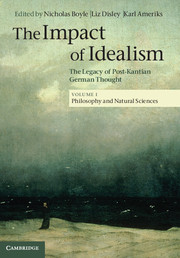12 results
Workflow and Outcome of Thrombectomy in Late Time Window: A Pooled Multicenter Analysis
-
- Journal:
- Canadian Journal of Neurological Sciences , First View
- Published online by Cambridge University Press:
- 19 April 2024, pp. 1-7
-
- Article
-
- You have access
- Open access
- HTML
- Export citation
Good is not Good Enough: The Benchmark Stroke Door-to-Needle Time Should be 30 Minutes
-
- Journal:
- Canadian Journal of Neurological Sciences / Volume 41 / Issue 6 / November 2014
- Published online by Cambridge University Press:
- 20 October 2014, pp. 694-696
-
- Article
-
- You have access
- HTML
- Export citation
List of Contributors
-
- Book:
- The Impact of Idealism
- Published online:
- 05 December 2013
- Print publication:
- 21 November 2013, pp viii-ix
-
- Chapter
- Export citation
List of Illustrations
-
- Book:
- The Impact of Idealism
- Published online:
- 05 December 2013
- Print publication:
- 21 November 2013, pp vii-vii
-
- Chapter
- Export citation

The Impact of Idealism
- The Legacy of Post-Kantian German Thought
-
- Published online:
- 05 December 2013
- Print publication:
- 21 November 2013
Acknowledgements
-
- Book:
- The Impact of Idealism
- Published online:
- 05 December 2013
- Print publication:
- 21 November 2013, pp x-xi
-
- Chapter
- Export citation
Index
-
- Book:
- The Impact of Idealism
- Published online:
- 05 December 2013
- Print publication:
- 21 November 2013, pp 421-431
-
- Chapter
- Export citation
List of Abbreviations
-
- Book:
- The Impact of Idealism
- Published online:
- 05 December 2013
- Print publication:
- 21 November 2013, pp xii-xiv
-
- Chapter
- Export citation
Contents
-
- Book:
- The Impact of Idealism
- Published online:
- 05 December 2013
- Print publication:
- 21 November 2013, pp v-vi
-
- Chapter
- Export citation
Bibliography
-
- Book:
- The Impact of Idealism
- Published online:
- 05 December 2013
- Print publication:
- 21 November 2013, pp 395-420
-
- Chapter
- Export citation
Frontmatter
-
- Book:
- The Impact of Idealism
- Published online:
- 05 December 2013
- Print publication:
- 21 November 2013, pp i-iv
-
- Chapter
- Export citation
1 - Hidden Markov processes in the context of symbolic dynamics
-
-
- Book:
- Entropy of Hidden Markov Processes and Connections to Dynamical Systems
- Published online:
- 05 June 2011
- Print publication:
- 26 May 2011, pp 5-71
-
- Chapter
- Export citation

